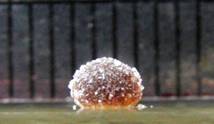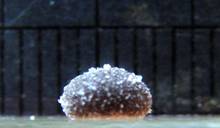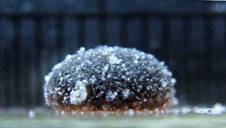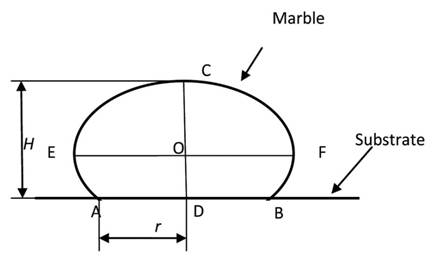Reports: UR552043-UR5: Manufacturing and Study of the Properties of Liquid Marbles Obtained with Crude Oil and Liquid Petroleum Products
Edward Bormashenko, PhD, Professor, Ariel University
The research was performed according to the milestones supplied in the proposal.
Liquid petroleum marbles were coated with the fluorinated decyl polyhedral oligomeric silsesquioxane (FD-POSS) hydrophobic powder according to the process reported in the narrative report summarizing the first year of the proposal. For preparing liquid marbles, drops of crude petroleum oil with the volumes 20–170 µl were deposited with a precise micropipette on a superoleophobic surface (see Bormashenko et al. Applied Surface Science 270 (2013) 98– 103) covered with a layer of FD-POSS powder. After careful rolling of droplets they turned to the marbles depicted in Fig. 1. Crude oil (petroleum) was supplied by Givot Olam Oil Ltd.
A
B
C
Fig. 1. Images of FD-POSS powder-coated petroleum oil marbles of different volumes: 10 µl (A), 20 µl (B) and 50 µl (C).
The marbles were visualized with a using a Ramé–Hart goniometer (model 500). The images were digitalized. The shape of marbles is well-described by the oblate spheroid model (G. Whyman, Ed. Bormashenko, J. Colloid & Interface Science 331 (2009) 174–177; Ed. Bormashenko, R. Pogreb, G. Whyman, Al. Musin, Ye. Bormashenko, Z. Barkay, Langmuir 25 (2009) 1893–1896). With the increase in the volume, marbles take more oblate form due to gravity, as shown in Fig. 1. Fig. 2 depicts parameters of crude oil marbles measured for calculating the effective surface tension. The contact diameter AB, the height CD, the maximal width EF of the droplet and two contact angles were measured from the images, and from these parameters the lengths of the spheroid hemi-axes EO and CO were obtained. The effective surface tension of marbles was calculated as described in detail in: Ed. Bormashenko, R. Pogreb, G. Whyman, Al. Musin, Ye. Bormashenko, Z. Barkay, Langmuir 25 (2009) 1893–1896 within the oblate spheroid model. Measured geometrical characteristics were compared to the values calculated within the above-mentioned oblate spheroid model for the droplet form. We applied a special algorithm using the Wolfram Mathematica software for fitting the calculated and measured geometrical characteristics.
Fig. 2. Scheme illustrating application of the oblate spheroid model for calculation of the effective surface tension of marbles.
The fitting procedure was carried according to the
procedure, described in G. Whyman, Ed. Bormashenko, J. Colloid & Interface
Science 331 (2009) 174–177.The average effective surface tension of marbles
comprising liquid petroleum was established as Measurement of the resonance frequencies of vibrated
marbles also allowed the establishment of their effective surface tension. To
calculate γeff , the equation derived in Celestini,
F., Kofman, R. Vibration of submillimeter-size
supported droplets, Physical Review E 2006; 73, 041602, was exploited:
where f , V
and θ are the resonance frequency, volume and apparent contact
angle of the marble respectively. For the values of the numerical multiplier h(θ)
see Celestini, F., Kofman, R. Vibration of submillimeter-size supported droplets, Physical Review E 2006;
7, 041602. Marbles were vibrated with an experimental device described in
Bormashenko, E.; Pogreb, R.; Whyman, G.; Erlich, M.
Langmuir 2007, 23, 6501–6503. The superoleophobic substrate with the marble was
bound up with the moving part of the vibration generator producing horizontal
vibrations. The horizontal laser beam illuminated all of the marble profile and
projected its enlarged image onto a screen using a system of lenses. The
amplitude of vibration was 100-150 μm. The
frequency of vibration was varied, and the lowest eigenfrequency
of the volume modes was fixed. The eigenfrequencies
of bulk vibrations of marbles containing liquid petroleum were established. The
average effective surface tension of marbles comprising liquid petroleum
established with the vibration method was established with Exp. 1 as γeff=25±2.5 mJ/m2.
The
paper “Liquid Marbles Containing Petroleum and Their Properties” summarizing
the abovementioned results was submitted to the Journal of Petroleum Science
and Engineering (PETROL5654). The paper is under review.
The comparison of effective surface tensions of
liquid marbles containing petroleum obtained by the “maximal height method”,
with the analysis of marbles' shape and with the vibration method demonstrated
the satisfactory coincidence, when the complicated hysteretic nature of the effective
surface tensions of liquid marbles is taken into account (see: Bormashenko et
al. Students involved in the research gained skills in the
synthesis of fluorinated decyl polyhedral oligomeric silsesquioxane
(FD-POSS) powder, the manufacturing superoleophobic surfaces, use of the
optical goniometer and the Wolfram Mathematica software, use of the laser
technique and cavitation rheology method, understanding the phenomenon of
resonance, the notion of eigenfrequency and preparing
scientific manuscripts.
In addition, within framework of the proposal we
reported for the first time the “shaped” cubic liquid marbles. The paper was
published in the high impact journal: In the published and submitted papers the acknowledgement
was made to the donors of the American Chemical Society Petroleum Research Fund
for support of this research (Grant 52043-UR5).
















